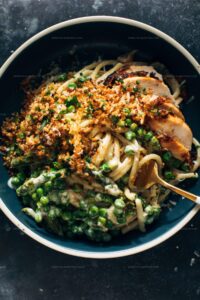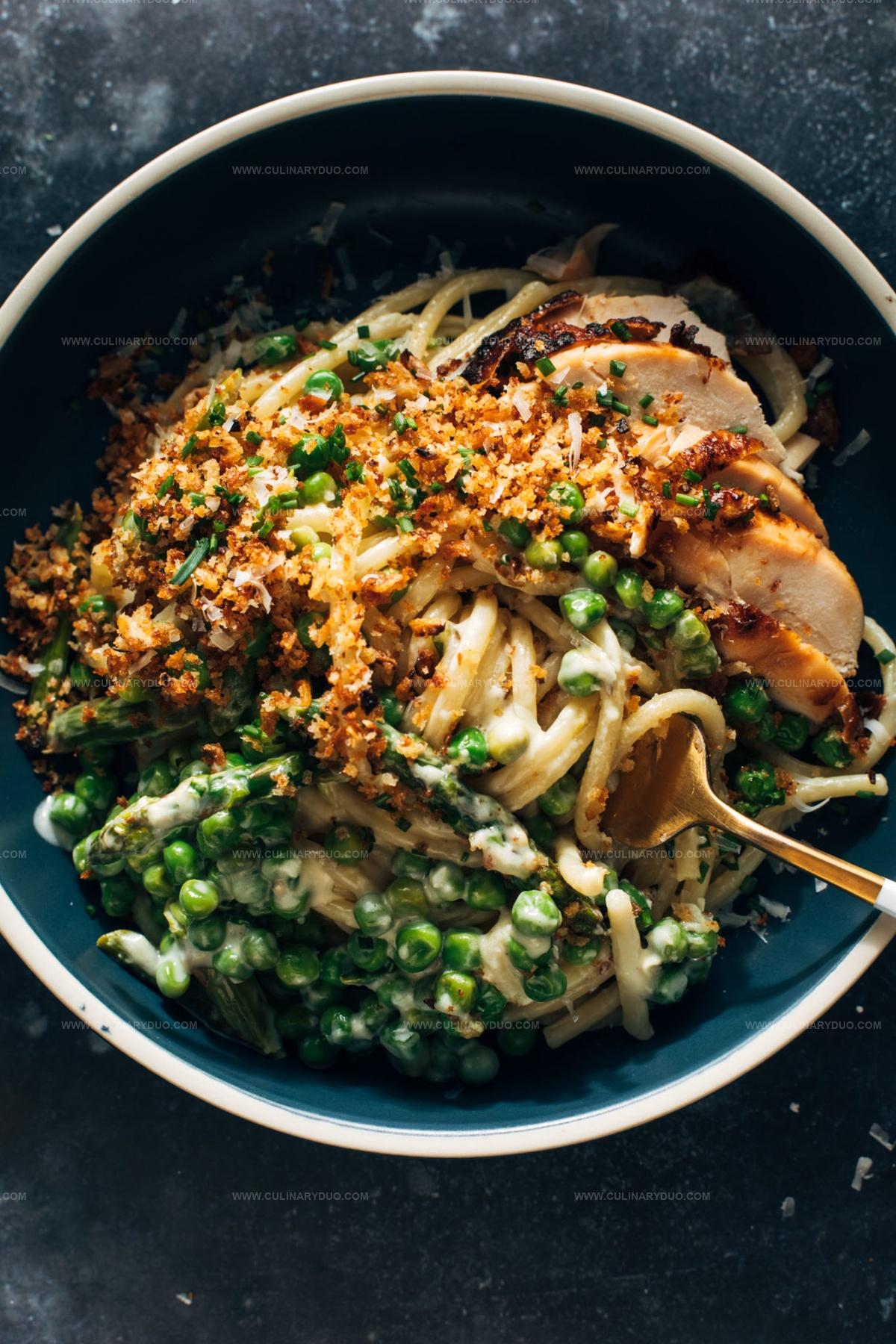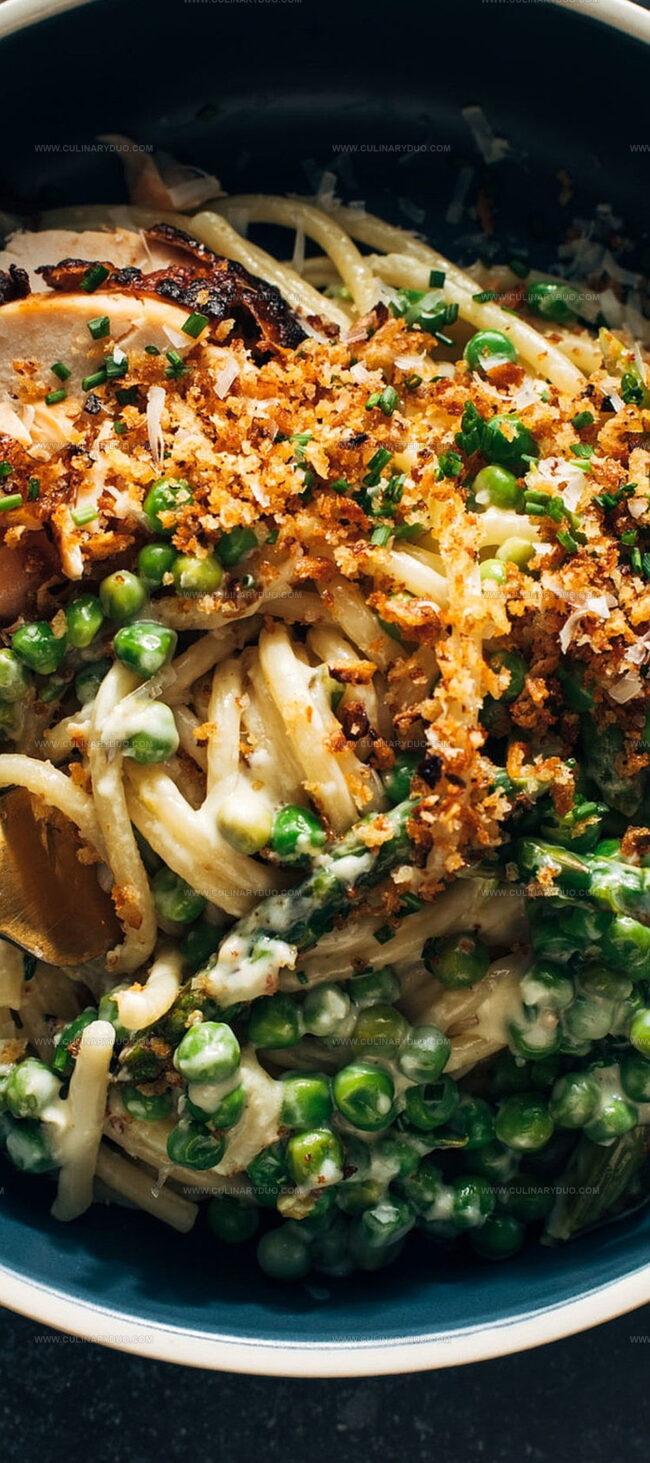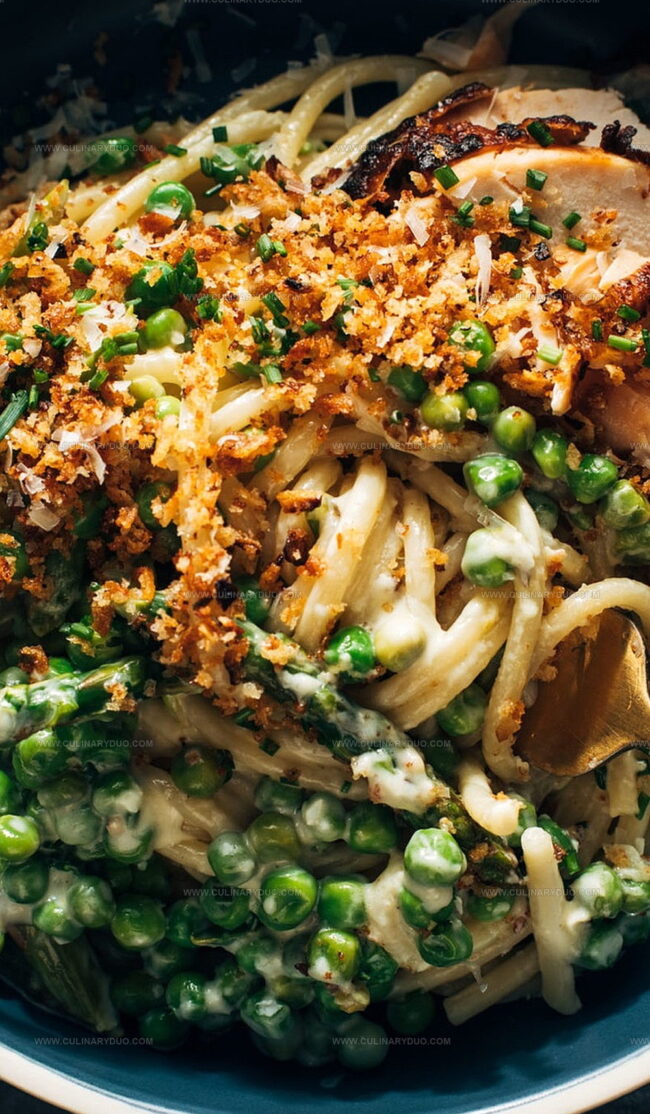Creamy Garlic Bucatini with Spring Peas & Asparagus Recipe
Creamy garlic cream bucatini dances with spring’s most vibrant vegetables in this irresistible pasta dish.
Delicate asparagus spears and sweet green peas nestle between silky strands of bucatini.
Italian comfort meets seasonal freshness through a luscious sauce that whispers elegance.
Pasta lovers will adore how each twirled bite combines rich garlic notes with tender green vegetables.
Minimal ingredients create maximum flavor in this simple yet sophisticated recipe.
Soft parmesan shavings and fresh herbs complete the plate’s beautiful symphony.
Garlic Cream Bucatini with Peas and Asparagus Overview
Essential Ingredients for Garlic Cream Bucatini
Main Ingredients:Dairy and Cream Components:Seasoning and Topping Ingredients:How to Make Garlic Cream Bucatini with Veggies
Step 1: Boil Pasta to Perfection
Cook the bucatini in salted water until it reaches that perfect al dente texture, following the package instructions carefully.
Drain and set aside, keeping the pasta warm.
Step 2: Sauté Asparagus
Heat a large skillet over medium heat.
Add butter and let it melt completely.
Toss in the asparagus and cook for about 5 minutes until it becomes tender and displays a vibrant green color.
The asparagus should still have a slight crunch.
Step 3: Infuse with Garlic
Introduce minced garlic to the skillet and sauté for 1-2 minutes until its aromatic fragrance fills the kitchen.
Step 4: Create Creamy Sauce
Pour in:Bring the mixture to a gentle simmer.
As the sauce begins to thicken, add frozen peas and let them cook for the final few minutes.
Brighten the sauce with:Step 5: Combine and Finish
Gently toss the pasta with the creamy sauce, keeping the skillet on low heat.
Allow the pasta to absorb the sauce for a few minutes, ensuring everything melds together beautifully.
Step 6: Prepare Crispy Breadcrumb Topping
In a separate skillet, toast panko breadcrumbs with olive oil until golden brown.
Season with:Mix in crushed crunchy onions for extra texture and crunch.
Step 7: Serve and Garnish
Top the pasta with the golden, crispy breadcrumb mixture.
For an extra protein boost, add rotisserie chicken or sautéed shrimp if desired.
Enjoy your restaurant-worthy meal!
Expert Tips for Garlic Cream Bucatini
Creative Swaps for Garlic Cream Bucatini
Best Serving Ideas for Garlic Cream Bucatini
Storing Garlic Cream Bucatini Safely
FAQs
Bucatini is ideal because its thick, hollow center helps capture the creamy sauce perfectly, but you can also use spaghetti or linguine as great alternatives.
Yes! Simply skip the optional chicken or shrimp and consider adding roasted mushrooms or white beans for extra protein and texture.
Keep the heat low and let the sauce simmer gently. The cream and broth will naturally thicken as they reduce, creating a perfect coating for the pasta.
Absolutely! Frozen peas work wonderfully in this recipe and save you time on preparation. Just add them directly from the freezer into the sauce during the final cooking minutes.
Print
Garlic Cream Bucatini with Peas and Asparagus Recipe
- Total Time: 25 minutes
- Yield: 2 1x
Description
Silky garlic cream bucatini dances with tender peas and crisp asparagus, creating a spring symphony on your plate. Creamy pasta lovers will swoon over this elegant Italian-inspired dish that brings seasonal freshness to your dining experience.
Ingredients
Main Ingredients:
- 1/2 pound (226 grams) bucatini pasta
- 1 cup (240 milliliters) heavy cream
- 3/4 cup (180 milliliters) chicken or vegetable broth
- 1.5 cups asparagus (ends trimmed and sliced diagonally)
- 1 heaping cup frozen peas
Aromatic and Seasoning Ingredients:
- 4 cloves garlic (grated)
- 2 tablespoons (30 grams) butter
- Zest of 1 lemon
- Lemon juice to taste
- Salt to taste
- Black pepper to taste
Garnish:
- Breadcrumbs (golden crispies)
Instructions
- Boil bucatini in salted water until perfectly al dente, following package instructions. Reserve a cup of pasta water before draining.
- Heat butter in a spacious skillet over medium temperature until melted and bubbling.
- Sauté asparagus for approximately 4-5 minutes, ensuring vibrant green color and slight tenderness.
- Introduce minced garlic to the skillet, stirring continuously for 1-2 minutes until aromatic and golden.
- Pour vegetable broth and heavy cream into the skillet, reducing heat to create a gentle simmer.
- Allow sauce to thicken gradually, then fold in frozen peas, cooking for an additional 2-3 minutes.
- Enhance flavor profile by adding fresh lemon juice, zest, kosher salt, and cracked black pepper.
- Gently incorporate cooked pasta into the creamy sauce, tossing thoroughly to ensure complete coating.
- Maintain low heat for 2-3 minutes, allowing pasta to absorb sauce and develop deeper flavors.
- For crispy topping, toast panko breadcrumbs in olive oil until golden brown.
- Season breadcrumbs with Italian herbs, garlic powder, salt, and pepper.
- Garnish pasta with seasoned breadcrumbs and optional protein like rotisserie chicken or sautéed shrimp.
Notes
- Toast breadcrumbs carefully to prevent burning, watching the skillet closely and stirring frequently for even golden color.
- Replace heavy cream with Greek yogurt or half-and-half for a lighter, lower-fat version that maintains creamy texture.
- Swap frozen peas with fresh seasonal vegetables like zucchini or bell peppers to customize the dish based on market availability.
- Add protein flexibility by incorporating rotisserie chicken, sautéed shrimp, or crispy tofu for vegetarian options that complement the creamy sauce.
- Prep Time: 10 minutes
- Cook Time: 15 minutes
- Category: Lunch, Dinner
- Method: Sautéing
- Cuisine: Italian
Nutrition
- Serving Size: 2
- Calories: 620 kcal
- Sugar: 4 g
- Sodium: 320 mg
- Fat: 38 g
- Saturated Fat: 22 g
- Unsaturated Fat: 14 g
- Trans Fat: 0.5 g
- Carbohydrates: 49 g
- Fiber: 6 g
- Protein: 15 g
- Cholesterol: 110 mg




Natalie Brooks
Co-Founder & Content Strategist
Expertise
Education
eCornell
Natalie brings the vibrant, plant-powered side to Culinary Duo. After earning her Plant-Based Nutrition Certificate from eCornell, she combined her love for fresh ingredients with a passion for storytelling, aiming to make healthy cooking simple and satisfying.
Her kitchen motto: good food doesn’t need a fancy label, it just needs fresh ideas and a little creativity. Outside of writing and recipe testing, Natalie’s happiest in her garden, exploring farmers’ markets, or mixing global flavors into new kitchen experiments.